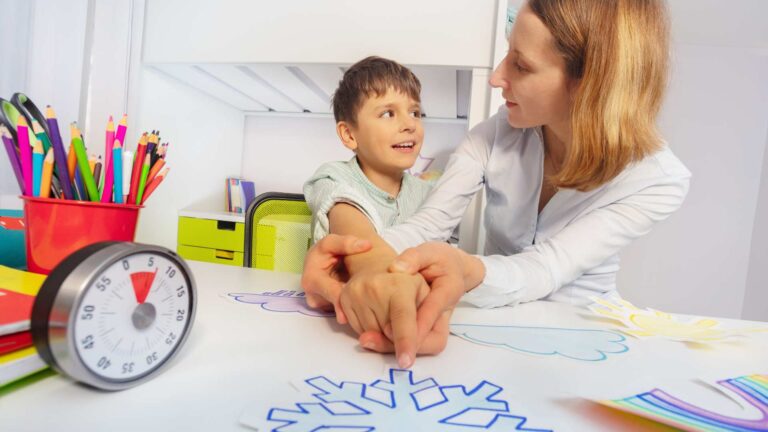Amid the difficulties many neurodivergent individuals experience, art therapy for autism spectrum disorder (ASD) emerges as a remarkable tool by establishing an outlet for many on the spectrum to utilize the artistic process to facilitate better self-expression, among other essential skills. In many cases, art therapy for autism acts as a powerful medium for better communication, expressivity, and emotional regulation while providing autism professionals with a multidimensional model to understand their clients more deeply.
This insight helps autism providers approach their client’s challenges with more playful, distinct support that’s enjoyable, meaningful, and gratifying, leading to more profound, positive long-term effects for those with ASD.
Navigating life on the spectrum can be a challenging and unique journey, both for those with an ASD diagnosis and the families who love them most. Alongside applied behavior analysis or ABA therapy and other autism-related modalities, art therapy is a promising intervention in the symptom management of ASD. It is particularly effective for many on the spectrum as it utilizes various visual arts and mediums, such as painting, molding clay, drawing, making music, dance/movement, and even drama.
This blog by ABA Centers of Georgia outlines the numerous benefits of art therapy for autism, including improved capacity for connection, increased self-awareness, and enhanced overall quality of life. Additionally, research by the American Journal of Occupational Therapy shows that receiving art therapy can lead to expanded participation and a willingness to engage further with other therapeutic interventions. So, keep reading to learn more about the specific benefits of art therapy for individuals with autism and how it can support many receiving ABA!
Click here for more information about ABA Centers of Georgia and how we serve the ASD community in regions including Atlanta, Alpharetta, Buckhead, and Marietta.
Understanding Autism Spectrum Disorder
Autism Spectrum Disorder is a developmental condition that can affect an individual’s ability to socialize, behave neurotypically, and navigate their environment, as described by research on sensory integration with autism by the University of Akron. It encompasses a wide range of conditions typically characterized by a few core challenges related to:
- Limited social skills
- Reoccurring, often rigid behaviors and mechanisms
- Deficits in nonverbal communication
However, it’s crucial also to recognize that behaviors in ASD can deviate in severity from person to person, meaning no two individuals on the spectrum are exactly alike. These challenges can make it tough for individuals with autism to express themselves appropriately and form meaningful bonds with others, and at times, even invite unwelcomed attention, which can be dangerous. Fortunately, treatment options like ABA, which focuses on behavior, address many challenging features typical in ASD children and teenagers.
Overview of Art Therapy and ABA Treatment
ABA focuses on identifying individualized goals and implementing behavior modification techniques to promote productive behaviors while redirecting those that may hinder autonomy and engaging with routine life. Art therapy is grounded in the belief that art can be a powerful tool to help individuals, including those with autism, express and process thoughts, experiences, and wellness.
In the context of autism treatment, ABA professionals can integrate therapeutic artistic expression into ABA programs as one of the many evidence-based interventions helpful in addressing skill deficits in autism, including social skills, self-regulation, and sensory sensitivities. Additionally, families may utilize art therapy with an art therapist alongside their loved one’s ABA treatment as a complimentary support for a more comprehensive, individualized approach.
Art therapy brings an added dimension to ABA treatment by offering a creative outlet for individuals with autism to explore their inner world in a safe, nonjudgmental environment with no limits and various mediums to enjoy. This approach is especially beneficial for those who struggle with verbal dialogue or have difficulty understanding social cues and interactions but feel resistance to learning more, which is not uncommon in ASD.
Finally, art therapy is also helpful as it allows for role play and practicing social encounters before they happen to address worry and concerns proactively. By engaging in this approach, individuals with ASD can learn to control themselves under various circumstances with greater ease, engage in more social experiences through art, and improve overall well-being through coping with outlets for understanding and reflection. Art therapy can also provide a break from structured ABA sessions, allowing for self-discovery in a new way.
In the best cases, art therapists and ABA providers collaborate to address concerns comprehensively, although the modalities are different.
Benefits of Art Therapy for Autism
Let’s take a closer look at some of the specific benefits that art therapy can offer for individuals with autism.
1. Improved Communication
For many, a core challenge of autism is difficulty with communication, both verbal and nonverbal, as explored earlier. Art therapy provides a unique chance for individuals with ASD to express themselves freely without the constraints of language, as they can draw, paint, dance, or write poems about their internal states and perspectives. Through various art forms, individuals can communicate their feelings in a safe way that is less overwhelming and easier for them to understand.
2. Increased Self-Awareness and Emotional Regulation
Individuals with autism often struggle with comprehending and managing their emotional experiences, which interventions like art therapy can help to address. Additionally, art therapists can help clients with ASD work on their awareness or learn more about how their actions may affect others through pictures or coloring.
Art therapy also encourages individuals to explore their identity and emotions through creative means, leading to the development of healthy coping mechanisms and new ways to manage adversity. These developments can help individuals with ASD learn to advocate their needs in a more constructive way that doesn’t promote destructive behavior like tantrums or aggression in some cases.
3. Enhanced Social Skills
Art therapy helps facilitate the development of social skills in individuals with autism in various ways. Participating in group art activities provides opportunities for individuals with ASD to practice critical social interactions, like taking turns, sharing materials, and working together towards a common goal. The act of passing crayons, sharing paint, or discussing their artwork promotes practice in social engagement, ultimately helping those on the spectrum refine their socialization and build connections with others through exposure.
4. Improved Sensory Processing
Some on the spectrum have trouble with surrounding sensory processing, leading them to respond to sensory input in unusual or heightened ways. Art therapy can provide a structured and tactile experience that can be calming and even soothing for individuals. In a controlled sensory environment, art offers an inviting way to engage with different textures, materials, and sensations to learn how to tolerate other sensory sensations.
5. Stress and Anxiety Reduction
Individuals with ASD often struggle with changes and transitions, among other variables, which can lead to anxiety and meltdowns. Art therapy can offer a helpful tool for coping with these challenges, as it encourages flexibility and adaptability in the artistic process. For some on the spectrum, creating art, making mistakes, redefining the rules, and learning through creative expressions serve to unwind from overwhelming emotions, leading to reduced levels of stress and fear.
6. Enhanced Overall Quality of Life
Ultimately, art therapy proves to have a favorable impact on the overall quality of life for individuals with ASD by providing a creative outlet for expression and self-understanding. Furthermore, art therapy can reduce help to stress, highlight talents, and offer innovative solutions that, for many, lead to better mood and overall sense of well-being. It can also increase self-esteem and confidence as individuals with autism see their unique creations come to life in a physical manifestation.
Art Therapy for Autism Makes the World a More Dynamic Place!
Caregivers should collaborate with certified art therapists who understand the nuances of both ASD and art therapy. These professionals should not only be adept in art techniques but also possess experience in working with individuals on the autism spectrum. Doing so ensures art therapy sessions cater to their specific needs and challenges so that clients can receive more profound results.
Furthermore, just like any autism service today, no approach to care is a one-size-fits-all solution. Every art therapy session should cater to the individual’s unique profile, considering their strengths, sensitivities, and cognitive abilities in addition to their goals and dreams. The most personal approaches ensure that the therapy is effective and valuable to the participant, offering helpful insight that furthers their development.
Ultimately, art therapy for autism is not just about creating beautiful art; it’s about creating a space where individuals on the spectrum can express the unspoken, explore challenges, and develop a sense of self and belonging. Artwork and the act of creating art can be a bridge to a world of possibilities for individuals with autism, offering benefits that extend beyond the therapy sessions.
More about ABA Centers of Georgia!
At ABA Centers of Georgia, we believe in comprehensive and evidence-based ABA care for children and teenagers with autism. Our team of board-certified behavior analysts (BCBAs) and Registered Behavior Technicians (RBTs) works closely with ASD families to develop custom therapy plans that address the individual needs of every client we serve on the spectrum that considers their passions and everyday interests, including creative outlets.
We understand the power of creativity and utilize art practices at times as a part of our ABA services for those who benefit from this form of therapy. For more information about our services, including autism diagnostic options, contact us via this online link or call us at (855) 929-5058.
Remember, the potential of individuals with autism to express themselves and connect with others through art is truly limitless.









